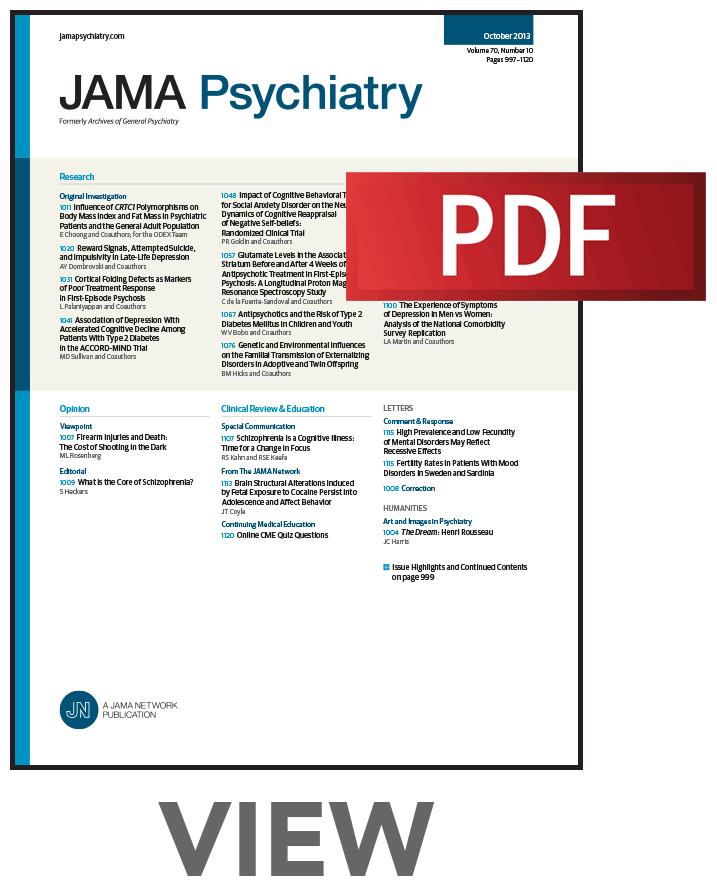Clinician Suicide Risk Assessment for Prediction of Suicide Attempt in a Large Health Care System
IF 22.5
1区 医学
Q1 PSYCHIATRY
引用次数: 0
Abstract
ImportanceClinical practice guidelines recommend suicide risk screening and assessment across behavioral health settings. The predictive accuracy of real-world clinician assessments for stratifying patients by risk of future suicidal behavior, however, remains understudied.ObjectiveTo evaluate routine clinical suicide risk assessment for prospectively predicting suicide attempt.Design, Setting, and ParticipantsThis electronic health record–based, prognostic study included 89 957 patients (≥5 years of age) with a structured suicide risk assessment (based on the Suicide Assessment Five-step Evaluation and Triage framework) that was documented by 2577 clinicians during outpatient, inpatient, and emergency department encounters at 12 hospitals in the Mass General Brigham health system between July 2019 and February 2023.Main Outcomes and MeasuresThe primary outcome was an emergency department visit with a suicide attempt code recorded in the electronic health record within 90 days or 180 days of the index suicide risk assessment. The predictive performance of suicide risk assessments was evaluated on a temporal test set first using stratified prevalence (clinicians’ overall risk estimates from a single suicide risk assessment item indicating minimal, low, moderate, or high risk) and then using machine learning models (incorporating all suicide risk assessment items).ResultsOf the 812 114 analyzed suicide risk assessments from the electronic health record, 58.81% were with female patients and 3.27% were with patients who were Asian, 5.26% were Black, 3.02% were Hispanic, 77.44% were White, and 11.00% were of Other or Unknown race. After suicide risk assessments were conducted during outpatient encounters, the suicide attempt rate was 0.12% within 90 days and 0.22% within 180 days; for inpatient encounters, the rate was 0.79% within 90 days and 1.29% within 180 days; and for emergency department encounters, the rate was 2.40% within 90 days and 3.70% within 180 days. Among patients evaluated during outpatient encounters, clinicians’ overall single-item risk estimates had an area under the curve (AUC) value of 0.77 (95% CI, 0.72-0.81) for 90-day suicide attempt prediction; among patients evaluated during inpatient encounters, the AUC was 0.64 (95% CI, 0.59-0.69); and among patients evaluated during emergency department encounters, the AUC was 0.60 (95% CI, 0.55-0.64). Incorporating all clinician-documented suicide risk assessment items (87 predictors) via machine learning significantly increased the AUC for 90-day risk prediction to 0.87 (95% CI, 0.83-0.90) among patients evaluated during outpatient encounters, 0.79 (95% CI, 0.74-0.84) among patients evaluated during inpatient encounters, and 0.76 (95% CI, 0.72-0.80) among patients evaluated during emergency department encounters. Performance was similar for 180-day suicide risk prediction. The positive predictive values for the best-performing machine learning models (with 95% specificity) ranged from 3.6 to 10.1 times the prevalence for suicide attempt.Conclusions and RelevanceClinicians stratify patients for suicide risk at levels significantly above chance. However, the predictive accuracy improves significantly by statistically incorporating information about recent suicidal thoughts and behaviors and other factors routinely assessed during clinical suicide risk assessment.大型医疗保健系统中用于预测自杀未遂的临床医生自杀风险评估
临床实践指南建议在行为健康设置中进行自杀风险筛查和评估。然而,现实世界中临床医生根据未来自杀行为风险对患者进行分层评估的预测准确性仍有待进一步研究。目的评价常规临床自杀风险评估对自杀倾向的前瞻性预测作用。设计、环境和参与者这项基于电子健康记录的预后研究纳入了89957名患者(≥5岁),并进行了结构化自杀风险评估(基于自杀评估五步评估和分诊框架),该评估由2577名临床医生在2019年7月至2023年2月期间在麻省总医院布里格姆卫生系统的12家医院的门诊、住院和急诊科就诊期间记录。主要结果和措施主要结果是在自杀风险指数评估后90天或180天内,在电子健康记录中记录自杀企图代码的急诊就诊。自杀风险评估的预测性能在一个时间测试集上进行评估,首先使用分层患病率(临床医生从单个自杀风险评估项目得出的总体风险估计,表明最低、低、中等或高风险),然后使用机器学习模型(纳入所有自杀风险评估项目)。结果在812114份电子健康档案中分析的自杀风险评估中,58.81%为女性,3.27%为亚裔,5.26%为黑人,3.02%为西班牙裔,77.44%为白人,11.00%为其他或未知种族。在门诊就诊时进行自杀风险评估后,90天内自杀未遂率为0.12%,180天内自杀未遂率为0.22%;住院就诊90天内为0.79%,180天内为1.29%;在急诊就诊中,90天内的比例为2.40%,180天内的比例为3.70%。在门诊就诊评估的患者中,临床医生对90天自杀企图预测的总体单项风险估计曲线下面积(AUC)值为0.77 (95% CI, 0.72-0.81);在住院期间评估的患者中,AUC为0.64 (95% CI, 0.59-0.69);在急诊就诊的患者中,AUC为0.60 (95% CI, 0.55-0.64)。通过机器学习纳入所有临床记录的自杀风险评估项目(87个预测因子),显著提高了90天风险预测的AUC,门诊评估的患者为0.87 (95% CI, 0.83-0.90),住院评估的患者为0.79 (95% CI, 0.74-0.84),急诊科评估的患者为0.76 (95% CI, 0.72-0.80)。180天自杀风险预测的结果与此相似。表现最好的机器学习模型(95%特异性)的阳性预测值范围为自杀企图患病率的3.6至10.1倍。结论与相关性临床医生对自杀风险水平的患者进行了显著高于偶然性的分层。然而,在临床自杀风险评估中,通过统计结合近期自杀想法和行为以及其他常规评估因素的信息,预测的准确性显著提高。
本文章由计算机程序翻译,如有差异,请以英文原文为准。
求助全文
约1分钟内获得全文
求助全文
来源期刊

JAMA Psychiatry
PSYCHIATRY-
CiteScore
30.60
自引率
1.90%
发文量
233
期刊介绍:
JAMA Psychiatry is a global, peer-reviewed journal catering to clinicians, scholars, and research scientists in psychiatry, mental health, behavioral science, and related fields. The Archives of Neurology & Psychiatry originated in 1919, splitting into two journals in 1959: Archives of Neurology and Archives of General Psychiatry. In 2013, these evolved into JAMA Neurology and JAMA Psychiatry, respectively. JAMA Psychiatry is affiliated with the JAMA Network, a group of peer-reviewed medical and specialty publications.
 求助内容:
求助内容: 应助结果提醒方式:
应助结果提醒方式:


